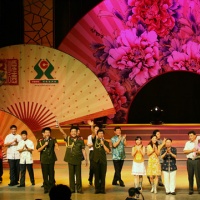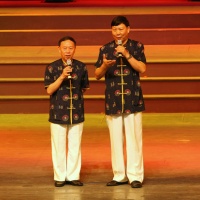- Home Page
- Fact Tours
Our sample tour itineraries of China and China travel packages are sorted by theme and available at competitive prices, you can browse what tours are right for you for your trip to China.
Popular China Tour Packages

Custom Tour Packages to China and Ask Our Experts for Free Enquiry !
- Coach Tours
- Destinations
Beijing, the capital of China. Its art treasures and universities have long made it a center of culture and art in China.
Beijing Top Attractions
Beijing City Tours
Best China Tours with Beijing
Shanghai, the cultural and economic center of East Asia. It renowned for its historical landmarks, the extensive and growing skyline.
Shanghai Top Attractions
Shanghai City Tours
Best China Tours with Shanghai
Xi'an, having held the position under several of the most important dynasties. It is the top destination to explore the facts of Chinese history.
Xi'an Top Attractions
Xi'an City Tours
Best China Tours with Xi'an
Huangshan boasts its culture, beautiful rivers, villages and mountains. It's home to 2 UNESCO World Heritage Sites and the Mecca of photographers.
Huangshan Top Attractions
Huangshan City Tours
Best China Tours with Huangshan
Sichuan is the cradle of the Shu culture, panda, mahjong, teahouse and spicy food. The province ranks first in China by number of UNESCO World Heritage Sites. It is called "the Heaven of Abundance".
Sichuan Top Attractions
Sichuan Tour Packages
Best China Tours with Sichuan
Yunnan, literally means the south of colorful clouds, due to its beautiful landscapes, mild climate and diverse ethnic cultures and traditions, is one of China's major tourist destinations.
Yunnan Top Attractions
Tibet, the nearest land to the sky, is known for its breathtaking landscape, splendid culture, art, buildings, and mysterious religions.
Tibet Top Attractions
Tibet Tour Packages
Best China Tours with Tibet
Explore the lost civilizations by riding a camel! Travel across the Gobi and the desert, and over the high mountains. Our Silk Road tours including different sections of the Silk Road in China.
Silk Road Top Attractions
Silk Road Tour Packages
Best China Tours with Silk Road
Guilin, an internationally-known historical and cultural city, has long been renowned for its unique karst scenery. Its vicinities are the paradise of hiking, caving, rafting, biking and countryside exploring.
Guilin Top Attractions
- China Facts
- China Hotels
- Travel Photos
Arts and Crafts
- Chinese Silk
- Chinese Sculpture & Carving
- Chinese Quyi
- Chinese Shadow Puppet Show
- Chinese Pearls
- Chinese Paper Cut
- Chinese Painting
- Chinese Music
- Chinese Lacquer Ware
- Chinese Wushu or Kung Fu
- Chinese Jade
- Chinese Games
- Chinese Dances
- Chinese Culture
- Chinese Ceramics
- Chinese Calligraphy
- Ancinent Chinese Bronze Vessels
- Chinese Acrobatics
Chinese Quyi
As an ancient performing art in China, Quyi is a general term that covers several different types of performances in which speech, singing or both are used. Quyi is profoundly rooted in Chinese time-honored history and culture. As an independent art, it was formed in the middle Tang Dynasty and flourished in the Song Dynasty. Now more than 400 forms of Quyi are popular among all ethnic groups throughout the country.
 The most influential and widespread forms are: Comic dialogue performances (xiangsheng), storytelling (pingshu), Suzhou or Yangzhou pinghua and the like are of speech form; Of singing form, there are jingyun dagu, meihua dugu, xihe dagu,shulaibao, Dongbei dagu, danxian; Of both speech and singing form, they are, kuaiban, Tianjin shidiao, er'-renzhuan, pingtan, Fengyang huagu, Shandong ginshu, Shandong kuaishu, Henan Zhuizi, Sichuan gingyin, Hubei daoqing, yuequ, Shanbei shuoshu and Mongolian haolaibao.
The most influential and widespread forms are: Comic dialogue performances (xiangsheng), storytelling (pingshu), Suzhou or Yangzhou pinghua and the like are of speech form; Of singing form, there are jingyun dagu, meihua dugu, xihe dagu,shulaibao, Dongbei dagu, danxian; Of both speech and singing form, they are, kuaiban, Tianjin shidiao, er'-renzhuan, pingtan, Fengyang huagu, Shandong ginshu, Shandong kuaishu, Henan Zhuizi, Sichuan gingyin, Hubei daoqing, yuequ, Shanbei shuoshu and Mongolian haolaibao.
Local Ethnic minority flavor features most of forms of Quyi. In the big Chinese family of 56 ethnic groups, each ethnic group has its own form of quyi. For example, the Tibetans sing and narrate the story of King Gesar and have a type of performance called Zhop, which is mainly singing.The Mongolians sing haolaibao and wnligeer. The Zhuang ethnic group is noted for its fenggu (Bee Drum) and molun performances. The Uygurs have rewafukexiake and dasitan; the Bai people sing d3bcnqu; the Miao ethnic group gebaifu; the Shui are noted for xuzao; and the Dai for zanha. A considerable number of quyi forms are shared by many ethnic groups, and it is difficult to attribute such quyi to any one group.
The quyi of Chinese ethnic minorities, as distinguished from Han Chinese quyi is prevalent in areas inhabited by racial groups in compact communities, using predominantly their own languages or dialects for the performances. The Changqu (sing type of quyi among many ethnic groups has unique musical instruments to accompany the singing. The taipinggu a kind of quyiperformed by the Manchu ethnic group, is derived from the drum used by shamanist priests. The dongbula form of string music and singing is derived from the Kazak instrument of the same name. Some forms of quyi of the ethnic minorities are sung in two or more languages as a result of the development and transmission of quyi through the ages.
forhu, an ancient quviform, mainly created by the Manchu, uses a mixture of the Manchu and Han languages. Scripts written in two languages are extant. To this day, singers of wnligeer in the Mongolian language in areas where Mongolians and Han live together still use both the Mongolian and Han languages to sing and tell stories. It is a universal phenomenon to find that each ethnic group draws on the good points of others to enrich its own art and Culture in story, character depiction, image and theme. The same hero is praised by different ethnic groups in different quyi forms. The treatment of events and singing and dancing varies from one ethnic group to another For instance, Wu Song, a hero in Han Chinese quyi has his equivalent in Mongolian quyi. Also, the legend of the Tibetan King Glear spread to Mongolia and he became a hero in the Mongols' taoli performance, which is a Mongolian form of quyi.  Quyi in fact, has been a major vehicle for the transmission of the history and culture of many ethnic groups. This in turn has led to quyi laoply preserving the features of primitive art in singing and story telling. its aesthetics are simple and unsophisticated, and of value for the study of aesthetics. There are about 400 forms of Quyi. All take speaking and singing as their major expression. Therefore, the language must be lively, simple, vivid as well as colloquial, and easy to memorize and recite. As Quyi arts employ speaking and singing as its major mediums, the artists have to try their best to stimulate the audiences through their words and songs so as to inspire them to conjure up images. Unlike to drama or opera, Quyi usually needs only one or two performers who may play several roles. In addition, the contents of Quyi are shorter and earthlier than other art forms, and the artists usually compose, edit and design by themselves.
Quyi in fact, has been a major vehicle for the transmission of the history and culture of many ethnic groups. This in turn has led to quyi laoply preserving the features of primitive art in singing and story telling. its aesthetics are simple and unsophisticated, and of value for the study of aesthetics. There are about 400 forms of Quyi. All take speaking and singing as their major expression. Therefore, the language must be lively, simple, vivid as well as colloquial, and easy to memorize and recite. As Quyi arts employ speaking and singing as its major mediums, the artists have to try their best to stimulate the audiences through their words and songs so as to inspire them to conjure up images. Unlike to drama or opera, Quyi usually needs only one or two performers who may play several roles. In addition, the contents of Quyi are shorter and earthlier than other art forms, and the artists usually compose, edit and design by themselves.
Performances consist usually of only one, two or three people, with simple props and no stage scenery. Major singing forms, such as danxian, jingyun dagu and meihua dagu, normally tell short stories and the songs are short. Some combine singing with speech, such as Suzhou pingtan and Xihe dagu, and these are often long pieces. Some are half sung and half spoken, such as kuaiban and Shandong Kuaishu.
Talking forms include pingshu and pinghua, which are used to tell long stories which continue over several months, in addition to xiangsheng, which involves short pieces that can be finished in a few minutes or even in a few lines. The performers sit as they sing in some forms, such as tanci, qinshu and pingshu, but walk up and down when singing in the er'renzhuan mode of Northeast China and the Fengyang huagu mode of Anhui Province. In other forms the performers stand, including dagu, uaiban, zhuizi, and qingyin. Singing is accompanied by musical instruments, clappers or drums. Instruments include sanxiafl, sihu and yangqin.
Quyi has a wide mass basis and a strongly Chinese flavor. Many excellent quyi items reflect the Chinese people's thought, ideals and moral aspirations; many works sing the praises of national heroes, honest officials, and faithful lovers. Currently, there are specialized quyi performing troupes and teams at central and local levels, such as the Central Broadcasting Recitation and Singing Troupe, Tianjin quyi Troupe, Shanghai Pingtan Troupe, Suzhou Pingtan Troupe, Shenyang Quyi Troupe and Sichuan Quyi Troupe. In addition, there are many amateur quyi troupes. Here top china travel introduces some of the most popular forms of Quyi to you.
Questions & Comments
Home | About Us | Partnerships | Terms & Conditions | Privacy & Security | Payment Guide | Resource Links| Sitemap
Email: contact@chinafacttours.com, Tel: +86-773-3810160, Fax: (+86) 773-3810333
Copyright © 2008-2022 China Fact Tours. All rights reserved
![]()









